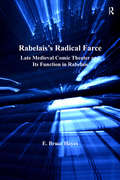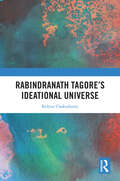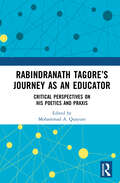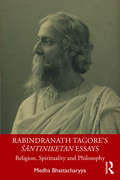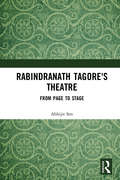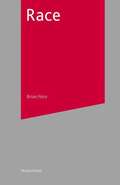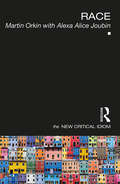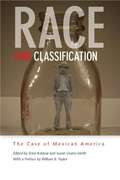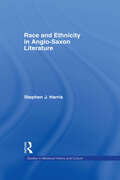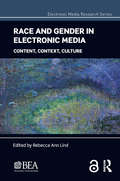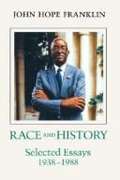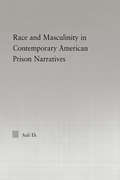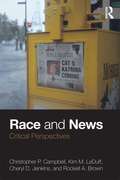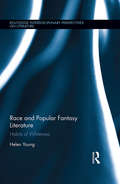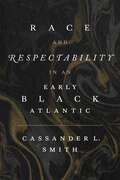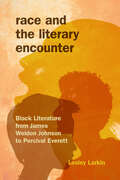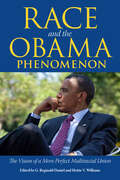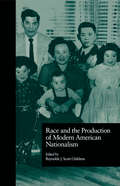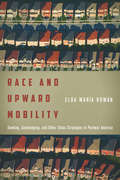- Table View
- List View
Rabelais and His World
by Mikhail M. Bakhtin Helene IswolskyThis classic work by the Russian philosopher and literary theorist Mikhail Bakhtin (1895-1975) examines popular humor and folk culture in the Middle Ages and the Renaissance. One of the essential texts of a theorist who is rapidly becoming a major reference in contemporary thought, Rabelais and His World is essential reading for anyone interested in problems of language and text and in cultural interpretation.
Rabelais's Carnival: Text, Context, Metatext (The New Historicism: Studies in Cultural Poetics #10)
by Samuel KinserHow is it possible, after four centuries, that a major episode in Rabelais's novels remains systematically misread? The episode, which playfully and grotesquely treats the relation of Carnival to Lent, occurs in Rabelais's Fourth Book, his last and most artfully crafted novel. Samuel Kinser argues that the text has been distorted because critics have not attended to the episode's performative as well as literary contexts, overlooking the innovative use Rabelais made in his work of his immediate world. In this original interpretation of the Fourth Book, Kinser evokes the gestures, games, and visual, oral, bodily semantics of Carnival and Lent as they were performed in Rabelais's day. He also underscores the importance to Rabelais of the invention of printing, an innovation which revolutionized the relationships of author and reader. Understanding this and fearing it, Rabelais adopted an extraordinary set of disguises as an author, disguises which in their bewildering interplay constitute the truest sense of his carnival. This title is part of UC Press's Voices Revived program, which commemorates University of California Press's mission to seek out and cultivate the brightest minds and give them voice, reach, and impact. Drawing on a backlist dating to 1893, Voices Revived makes high-quality, peer-reviewed scholarship accessible once again using print-on-demand technology. This title was originally published in 1990.
Rabelais's Radical Farce: Late Medieval Comic Theater and Its Function in Rabelais
by E. Bruce HayesIn the first extended investigation of the importance of dramatic farce in Rabelais studies, Bruce Hayes makes an important contribution to the understanding of the theater of farce and its literary possibilities. By tracing the development of farce in late medieval and Renaissance comedic theater in comparison to the evolution of farce in Rabelais's work, Hayes distinguishes Rabelais's use of the device from traditional farce. While traditional farce is primarily conservative in its aims, with an emphasis on maintaining the status quo, Rabelais puts farce to radical new uses, making it subversive in his own work. Bruce Hayes examines the use of farce in Pantagruel, Gargantua, and the Tiers and Quart livres, showing how Rabelais recast farce in a humanist context, making it a vehicle for attacking the status quo and posing alternatives to contemporary legal, educational, and theological systems. Rabelais's Radical Farce illustrates the rich possibilities of a genre often considered simplistic and unsophisticated, disclosing how Rabelais in fact introduced both a radical reformulation of farce, and a new form of humanist satire.
Rabindranath Tagore's Ideational Universe
by Bidyut ChakrabartyThis book explores Tagore’s socio-political ideas through his novels, short stories, and essays. It looks at Tagore beyond his literary achievements and examines his notions of friendship, religion, nationalism, civilization, and knowledge. It highlights his uniquely textured and innovatively argued views on critical aspects of humanity in the tumultuous phase of Indian nationalist campaign that also witnessed a kaleidoscope of myriad ideological voices, besides the hegemonic mainstream nationalist campaign, led by Gandhi. It captures the bard’s creative ideational priorities and his attempts to radically transform the prevalent socio-economic and politico-cultural environment. The volume will be of great interest to scholars and researchers of history, politics, literature, and South Asian studies.
Rabindranath Tagore’s Journey as an Educator: Critical Perspectives on His Poetics and Praxis
by Mohammad A. QuayumThis book looks at Rabindranath Tagore’s, experiments and journey as an educator and the influence of humanistic worldviews, nationalism and cosmopolitanism in his philosophy of education. It juxtaposes the educational systems and institutions set up by the British colonial administration with Tagore’s pedagogical vision and schools in Santiniketan, West Bengal—Brahmacharya Asram (1901), Visva-Bharati University (1921) and Sriniketan Institute of Village Reconstruction (1922). An educational pioneer and a poet-teacher, Tagore combined nature and culture, tradition and modernity, East and West, in formulating his educational methodology. The essays in this volume analyse the relevance of his theories and practice in encouraging greater cultural exchange and the dissolution of the walls between classrooms and communities. This book will be useful for scholars and researchers of education, Tagore studies, literature, cultural studies, sociology of education, South Asian studies and colonial and postcolonial studies.
Rabindranath Tagore's Śāntiniketan Essays: Religion, Spirituality and Philosophy
by Medha BhattacharyyaThis book provides a critical introduction and translation of fifty Śāntiniketan (Abode of Peace) essays written by Rabindranath Tagore between 1908 and 1914. It provides key insights into Tagore’s fundamental meditations on life, nature, religion, philosophy and the world at large. As the first of its kind, this volume is a definitive collection of Tagore’s Śāntiniketan essays translated into English which contains a substantial amount of scholarly material on them. The essays look at Tagore’s ideas of universality, his socio-cultural location along with the development of his thought, his reflections on Buddhism, Vaiṣṇavism, Bāul philosophy, the Bhagavadgītā and to a great extent the Upanishads and their contemporary relevance. It also connects Sri Ramakrishna’s concepts of vijnāna and bhāvamukha with Tagore’s thought, an original contribution, through the study of these essays. A nuanced exploration into translation theory and praxis, it fills a lacuna in Tagore Studies by bringing to the fore profound religious, spiritual and philosophical knowledge in Tagore’s own voice. This volume will be useful for scholars and researchers of Translation Studies, Tagore Studies, Language and Literature, Cultural Studies and readers interested in Tagore’s philosophical ideas.
Rabindranath Tagore's Theatre: From Page to Stage
by Abhijit SenThis book analyses Rabindranath Tagore’s contribution to Bengali drama and theatre. Throughout this book, Abhijit Sen locates and studies Rabindranath’s experiments with drama/theatre in the context of the theatre available in nineteenth-century Bengal, and explores the innovative strategies he adopted to promote his ‘brand’ of theatre. This approach finds validation in the fact that Rabindranath combined in himself the roles of author-actor-producer, who always felt that, without performance, his dramatic compositions fell short of the desired completeness. Various facets of his plays as theatre and his own role as a theatre-practitioner are the prime focus of this book. This book will be of great interest to students and scholars in Theatre and Performance Studies and most notably, those focusing on Indian Theatre and Postcolonial Theatre.
Raccontare personaggi: ovvero come creare persone che i tuoi lettori ameranno
by Susan PalmquistHai difficoltà a creare i tuoi personaggi o ricevi lettere di rifiuto ma sei abbastanza sicuro di avere una trama che spacca? Non è sempre la trama che i lettori ricordano di più di un libro, ma uno o più personaggi che catturano la loro attenzione, mantengono il loro interesse e li costringono a continuare a leggere per scoprire cosa succede. Sono le persone della tua storia che chiamano il lettore fin dalla prima pagina e gli dicono: "Ho una storia da raccontarti, vuoi venire con me?". Ecco perché ho creato questa breve guida. Non si tratta tanto di come creare un grande personaggio, quanto di una serie di esercizi da provare per aiutarti a creare persone tridimensionali e realistiche ogni volta che ti siedi a scrivere, riducendo così le possibilità che la tua storia venga rifiutata o che tu non riesca a colpire nel segno i tuoi lettori. Una volta che li avrai affrontati tutti e dieci, conoscerai il tuo personaggio come il tuo migliore amico, e forse lo conoscerai anche meglio di te stesso.
Race (Transitions Ser.)
by Brian NiroThis dynamic study of the history of the idea of race traces the concept from its prehistory across 400 years to its current status. Brian Niro introduces key theorists and philosophers and a wide variety of literary and theoretical concepts, taking the central view that the notion of race is a fluid concept that has altered consistently since its inception in Western ideology. Starting with Greek philosophy, Niro moves effortlessly through such diverse writers as Shakespeare, Voltaire, Kant, Mary Shelly, Darwin, Fanon and Achebe in order to explore the representation of race in its various guises. Many contemporary discussions of race are intricate and limited in their scope to current doctrine, but by using a series of close readings of often-studied texts, Niro helps to demonstrate key ideas and make complex theories understandable.
Race (The New Critical Idiom)
by Martin Orkin Alexa Alice JoubinRace offers a compelling introduction to the study of ideas related to race throughout history. Its breadth of coverage, both geographically and temporally, provides readers with an expansive, global understanding of the term from the classical period onwards. This concise guide offers an overview of: Intersections of Race and Gender Race and Social Theory Identity, Ethnicity, and Immigration Whiteness Legislative and Judicial Markings of Difference Race in South Africa, Israel, East Asia, Asian America Blackness in a Global Context Race in the History of Science Critical Race Theory This clear and engaging study is essential reading for students of Literature, Culture, and Race.
Race and Classification: The Case of Mexican America
by Susan Deans-Smith Ilona KatzewAn exhibition of 18th-century casta painting at the Los Angeles County Museum of Art in 2004 occasioned a Mayday symposium from which the nine essays here emerged. Art and other historians, other scholars, and writers and artists explore the concepts and depictions of race in Mexico across the boundary from colonial to modern that is associated with the painting genre. Their topics include the language, genealogy, and classification of race in colonial Mexico; Moctezuma through the centuries; Hispanic identities in the southwestern US; and reconfiguring race, gender, and Chicano/a identity in film. Annotation c2010 Book News, Inc. , Portland, OR (booknews. com)
Race and Ethnicity in Anglo-Saxon Literature (Studies in Medieval History and Culture #24)
by Stephen HarrisWhat makes English literature English ? This question inspires Stephen Harris's wide-ranging study of Old English literature. From Bede in the eighth century to Geoffrey of Monmouth in the twelfth, Harris explores the intersections of race and literature before the rise of imagined communities. Harris examines possible configurations of communities, illustrating dominant literary metaphors of race from Old English to its nineteenth-century critical reception. Literary voices in the England of Bede understood the limits of community primarily as racial or tribal, in keeping with the perceived divine division of peoples after their languages, and the extension of Christianity to Bede's Germanic neighbours was effected in part through metaphors of family and race. Harris demonstrates how King Alfred adapted Bede in the ninth century; how both exerted an effect on Archbishop Wulfstan in the eleventh; and how Old English poetry speaks to images of race.
Race and Gender in Electronic Media: Content, Context, Culture (Electronic Media Research Series)
by Rebecca Ann LindThis volume examines the consequences, implications, and opportunities associated with issues of diversity in the electronic media. With a focus on race and gender, the chapters represent diverse approaches, including social scientific, humanistic, critical, and rhetorical. The contributors consider race and gender issues in both historical and contemporary electronic media, and their work is presented in three sections: content, context (audiences, effects, and reception), and culture (media industries, policy, and production). In this book, the authors investigate, problematize, and theorize a variety of concerns which at their core relate to issues of difference. How do we use media to construct and understand different social groups? How do the media represent and affect our engagement with and responses to different social groups? How can we understand these processes and the environment within which they occur? Although this book focuses on the differences associated with race and gender, the questions raised by and the theoretical perspectives presented in the chapters are applicable to other forms of socially-constructed difference. Chapters 5, 10, 12, and 19 of this book are freely available as downloadable Open Access PDFs at http://www.taylorfrancis.com under a Creative Commons Attribution-Non Commercial-No Derivatives (CC-BY-NC-ND) 4.0 license.
Race and History: Selected Essays 1938-1988
by John Hope FranklinThe essays are presented thematically and include pieces on southern history, significant but neglected historical figures, historiography, the connection between historical problems and contemporary issues, and the public role of the historian. His career has spanned a half century and in many ways parallels the emergence of Afro-American history as a legitimate area of inquiry.
Race and Identity in D. H. Lawrence
by Judith RudermanRace and Identity in D. H. Lawrence is a wide-ranging examination of Lawrence's adoption and adaptation of stereotypes about minorities, with a focus on three particular 'racial' groups. This book explores societal attitudes in England, Europe, and the United States and Lawrence's utilization of cultural norms to explore his own identity.
Race and Masculinity in Contemporary American Prison Novels
by Auli EkThis book offers an interdisciplinary analysis of how contemporary American prison narratives reflect and produce ideologies of masculinity in the United States, and in so doing, compellingly engages popular culture in order to demonstrate the profound ways in which implicit understandings of prison life shape all Americans, and their reactions to people both incarcerated and not.
Race and News: Critical Perspectives
by Christopher P. Campbell Rockell A. Brown Cheryl D. Jenkins Kim M. LeDuffThe history of American journalism is marked by disturbing representations of people and communities of color, from the disgraceful stereotypes of pre-civil rights America, to the more subtle myths that are reflected in routine coverage by journalists all over the country. Race and News: Critical Perspectives aims to examine these journalistic representations of race, and in doing so to question whether or not we are living in a post-racial world. By looking at national coverage of stories like the Don Imus controversy, Hurricane Katrina, Barak Obama's presidential candidacy, and even the Virginia Tech shootings, readers are given an opportunity to gain insight into both subtle and overt forms of racism in the newsroom and in national dialogue. The book itself is divided into two sections, with the first examining the journalistic routine and the decisions that go into covering a story with, or without, relation to race. The second section, comprised of case studies, explores the coverage of national stories and how they have impacted the dialogue on race and racism in the United States. As a whole, the collection of essays and studies also reflects a variety of research approaches. With a goal of contributing to the discussion about race and its place in American journalism, this broad examination makes Race and News an ideal text for courses on cultural diversity and the media, as well as making it valuable to professional journalists and journalism students who seek to improve their approach to coverage of diverse communities.
Race and Popular Fantasy Literature: Habits of Whiteness (Routledge Interdisciplinary Perspectives on Literature)
by Helen YoungThis book illuminates the racialized nature of twenty-first century Western popular culture by exploring how discourses of race circulate in the Fantasy genre. It examines not only major texts in the genre, but also the impact of franchises, industry, editorial and authorial practices, and fan engagements on race and representation. Approaching Fantasy as a significant element of popular culture, it visits the struggles over race, racism, and white privilege that are enacted within creative works across media and the communities which revolve around them. While scholars of Science Fiction have explored the genre’s racialized constructs of possible futures, this book is the first examination of Fantasy to take up the topic of race in depth. The book’s interdisciplinary approach, drawing on Literary, Cultural, Fan, and Whiteness Studies, offers a cultural history of the anxieties which haunt Western popular culture in a century eager to declare itself post-race. The beginnings of the Fantasy genre’s habits of whiteness in the twentieth century are examined, with an exploration of the continuing impact of older problematic works through franchising, adaptation, and imitation. Young also discusses the major twenty-first century sub-genres which both re-use and subvert Fantasy conventions. The final chapter explores debates and anti-racist praxis in authorial and fan communities. With its multi-pronged approach and innovative methodology, this book is an important and original contribution to studies of race, Fantasy, and twenty-first century popular culture.
Race and Respectability in an Early Black Atlantic
by Cassander L. SmithRace and Respectability in an Early Black Atlantic examines the means through which people of African descent embodied tenets of respectability as a coping strategy to navigate enslavement and racial oppression in the early Black Atlantic world. The term “respectability politics” refers to the way members of a minoritized population adopt the customs and manners of a dominant culture in order to gain visibility and combat negative stereotypes about their subject group. Today respectability politics can be seen in how those within and outside Black communities police the behavior of Black celebrities, critique protest movements, and celebrate accomplishments by people of African descent who break racial barriers.To study the origins of the complicated relationship between race and respectability, Cassander L. Smith shows that early American literatures reveal Black communities engaging with issues of respectability from the very beginning of the transatlantic slave trade. Concerns about character and comportment influenced the literary production of Black Atlantic communities, particularly in the long eighteenth century. Uncovering the central importance of respectability as a theme shaping the literary development of cultures throughout the early Black Atlantic, Smith illuminates the mechanics of respectability politics in a range of texts, including poetry, letters, and life writing by Phillis Wheatley, Olaudah Equiano, and expatriates on the west coast of Africa in Sierra Leone.Through these early Black texts, Race and Respectability in an Early Black Atlantic considers respectability politics as a malleable strategy that has both energized and suppressed Black cultures for centuries.
Race and the Literary Encounter: Black Literature from James Weldon Johnson to Percival Everett (Blacks in the Diaspora)
by Lesley LarkinWhat effect has the black literary imagination attempted to have on, in Toni Morrison's words, "a race of readers that understands itself to be 'universal' or race-free"? How has black literature challenged the notion that reading is a race-neutral act? Race and the Literary Encounter takes as its focus several modern and contemporary African American narratives that not only narrate scenes of reading but also attempt to intervene in them. The texts interrupt, manage, and manipulate, employing thematic, formal, and performative strategies in order to multiply meanings for multiple readers, teach new ways of reading, and enable the emergence of antiracist reading subjects. Analyzing works by James Weldon Johnson, Zora Neale Hurston, Ralph Ellison, Jamaica Kincaid, Percival Everett, Sapphire, and Toni Morrison, Lesley Larkin covers a century of African American literature in search of the concepts and strategies that black writers have developed in order to address and theorize a diverse audience, and outlines the special contributions modern and contemporary African American literature makes to the fields of reader ethics and antiracist literary pedagogy.
Race and the Obama Phenomenon: The Vision of a More Perfect Multiracial Union
by G. Reginald Daniel and Hettie V. WilliamsThe concept of a more perfect union remains a constant theme in the political rhetoric of Barack Obama. From his now historic race speech to his second victory speech delivered on November 7, 2012, that striving is evident. “Tonight, more than two hundred years after a former colony won the right to determine its own destiny, the task of perfecting our union moves forward,” stated the forty-fourth president of the United States upon securing a second term in office after a hard-fought political contest. Obama borrows this rhetoric from the founding documents of the United States set forth in the US Constitution and in Abraham Lincoln's “Gettysburg Address.” How naive or realistic is Obama's vision of a more perfect American union that brings together people across racial, class, and political lines? How can this vision of a more inclusive America be realized in a society that remains racist at its core? These essays seek answers to these complicated questions by examining the 2008 and 2012 elections as well as the events of President Obama's first term. Written by preeminent race scholars from multiple disciplines, the volume brings together competing perspectives on race, gender, and the historic significance of Obama's election and reelection. The president heralded in his November 2012, acceptance speech, “The idea that if you're willing to work hard, it doesn't matter who you are, or where you come from, or what you look like . . . . whether you're black or white, Hispanic or Asian or Native American.” These essayists argue the truth of that statement and assess whether America has made any progress toward that vision.
Race and the Production of Modern American Nationalism (Wellesley Studies in Critical Theory, Literary History and Culture #No. 18)
by Reynolds J. Scott-childressFirst published in 1999. Routledge is an imprint of Taylor & Francis, an informa company.
Race and the Rhetoric of Resistance
by Jeffrey B. FergusonContinuing in the vein of his ever questioning the conventions of race melodrama through the lens of which so much American racial and cultural history and storytelling has been filtered, Ferguson's final work conveys to the reader his sense of humor, warmth, and grace, while adding up to a serious, principled critique of much common scholarly and pedagogic practice..
Race and the Totalitarian Century
by Vaughn RasberryVaughn Rasberry turns to black culture and politics for an alternative history of the totalitarian century. He shows how black writers reimagined the standard anti-fascist, anti-communist narrative through the lens of racial injustice, with the U.S. as a tyrannical force in the Third World but also an agent of Asian and African independence.
Race and Upward Mobility: Seeking, Gatekeeping, and Other Class Strategies in Postwar America
by Elda María RománOver the course of the twentieth and twenty-first centuries, Mexican American and African American cultural productions have seen a proliferation of upward mobility narratives: plotlines that describe desires for financial solvency, middle-class status, and social incorporation. Yet the terms "middle class" and "upward mobility"—often associated with assimilation, selling out, or political conservatism—can hold negative connotations in literary and cultural studies. Surveying literature, film, and television from the 1940s to the 2000s, Elda María Román brings forth these narratives, untangling how they present the intertwined effects of capitalism and white supremacy. Race and Upward Mobility examines how class and ethnicity serve as forms of currency in American literature, affording people of color material and symbolic wages as they traverse class divisions. Identifying four recurring character types—status seekers, conflicted artists, mediators, and gatekeepers—that appear across genres, Román traces how each models a distinct strategy for negotiating race and class. Her comparative analysis sheds light on the overlaps and misalignments, the shared narrative strategies, and the historical trajectories of Mexican American and African American texts, bringing both groups' works into sharper relief. Her study advances both a new approach to ethnic literary studies and a more nuanced understanding of the class-based complexities of racial identity.


